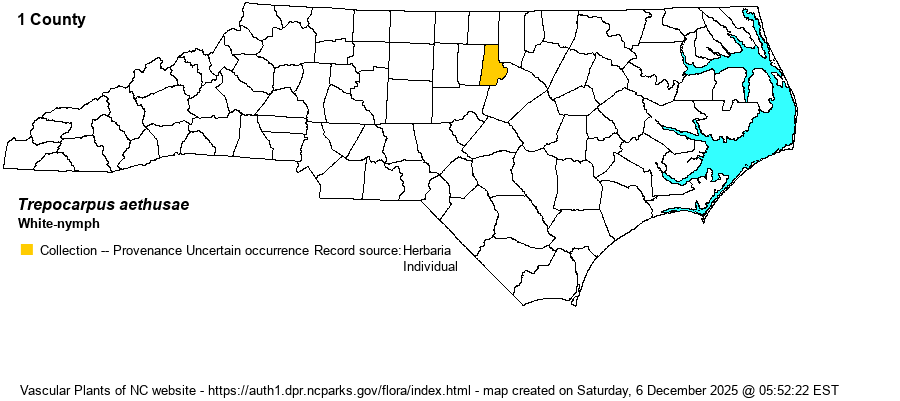| Author | Nutt. ex DC. | |
| Distribution | Discovered by Milo Pyne on 31 July 2020 from New Hope Creek floodplain, Durham County (photo confirmed by experts); specimen (NCU) placed onto the SERNEC database in spring 2021. Originally thought to be a native occurrence, subsequent survey work has suggested that the New Hope Creek population may have become established in the 1990s (with development of an apartment complex) and/or in 2007 (with clearing for a sewerline) (Hall and Tingley 2023).
This species is found mainly in the south-central states, ranging eastward to central TN and central SC. The SC occurrences are thought to be natural (fide K. Bradley 2020); and for now the editors are treating the NC record as Provenance Uncertain, as the habitat is appropriate for the species in its main range. | |
| Abundance | Very rare in NC; disjunct from central SC. The NCNHP added this species to its Watch List in 2021. A mapping survey conducted in 2023 (Hall and Tingley 2023) yielded several clusters of plants plus scattered individuals. While they did not estimate total population size, it appears that there are many dozens of plants. However, the authors reported that plants occur in drier, disturbed soils above the floodplain, and they suggest that those areas may have been the original source of the plants that now occur in the floodplain. Hall and Tingley recommend a state rank of SE (Exotic), but for now the website editors will take a more cautious course and treat White-nymph as Provenance Uncertain. In late 2024, the NCNHP changed the State Rank to SNA (Not Applicable), as it may well be not native; the Watch List status has been removed. | |
| Habitat | Primarily in Triassic Basin swamp forest in NC. Hall and Tingley (2023) also noted it in a mown field by an apartment complex and also in a sewerline easement. Elsewhere in its range, found in swamp forest openings, along river margins, and in other alluvial habitats, including sand and gravel bars; also rather weedy in fields, disturbed ground. | |
| Phenology | Immature fruits on 31 July. Normally flowers and fruits May-June (RAB 1968) -- for SC sites. | |
| Identification | Trepocarpus has only one species, and the leaves and fruits do not look quite like any other members of the umbel family in NC. The plants grow 1-2 feet tall, glabrous, with alternate, pale green leaves. The leaves are pinnately dissected into a fernlike aspect, the ultimate segments linear and short-tapered to a point. Compound umbels are composed of 2-4 umbels, all on long stalks from upper leaf axils. Each umbel has 2-8 white flowers about 2 mm across. The fruits are cylindrical, 8-10 mm long, strongly ribbed lengthwise, brownish with a green tip. | |
| Taxonomic Comments | A monotypic genus endemic to the U.S.
| |
| Other Common Name(s) | None | |
| State Rank | SE? | |
| Global Rank | G4G5 | |
| State Status | | |
| US Status | | |
| USACE-agcp | | |
| USACE-emp | | |

